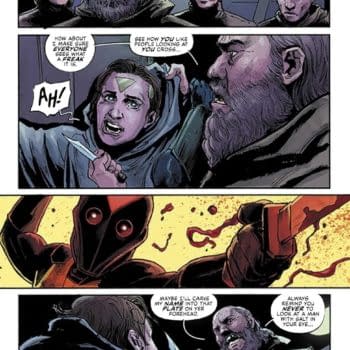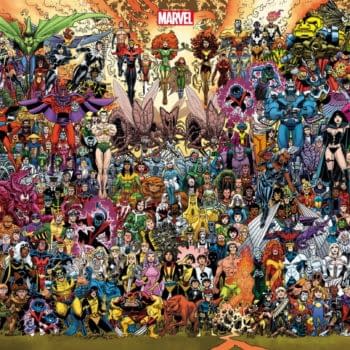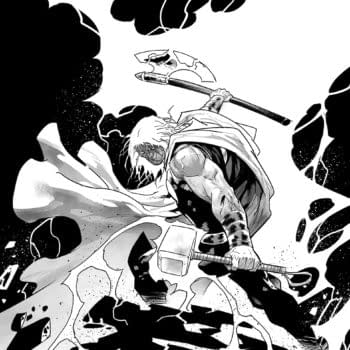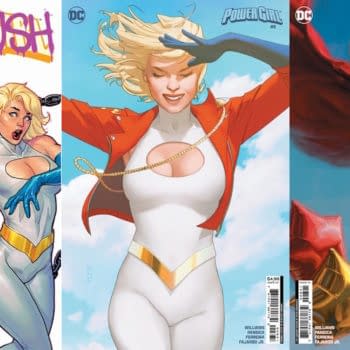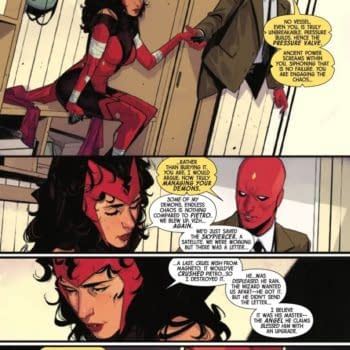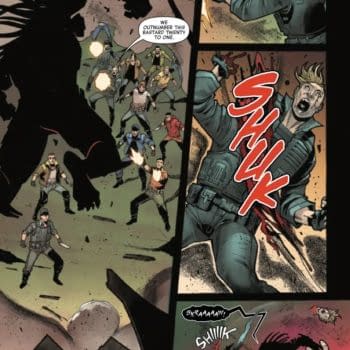Posted in: Comics | Tagged: Comics, dc, entertainment, gendercrunching, marvel
Gendercrunching March 2012 by Tim Hanley
Tim Hanley writes for Bleeding Cool;
DC stayed the same in March, but Marvel broke the record for the highest percentage of female creators since we began keeping track 15 months ago!! Marvel's on a bit of a tear lately. Also, we take a look at our usual numbers in a different way.
DC COMICS
While Marvel was busy smashing records, DC had a perfectly average month, landing on its favourite number yet again. In March 2012, DC Comics released 85 new books with 694 credited creators, 618 men and 76 women. Here are their stats:
That's the exact same overall total as last month, so good work being consistent. On the creative side, writers and inkers were down about a percentage point, while cover artists and letterers fell only 0.1%. Pencillers were up 0.9%, though, and colorists rose 1.3%. In editorial, editors were up 1.2% but assistant editors slid down a steep 5.6%. All together, it evened out to their usual total with only one category changing in any big way.
Compared To A Year Ago: In March 2011, DC's overall percentage of female creators was 11.4%, so they're down 0.4% comparatively.
MARVEL COMICS
The old record was 12.5%, set by DC in May 2011, but now that record's been broken. In March 2012, Marvel put out 74 new comics featuring 620 credited creators, 541 men and 79 women. Let's look at their numbers:
Not only did Marvel break the record, they're also up an impressive 1.7% from last month. However, there were a lot of drops by category. For the creative side, only writers went up, gaining a nice 3.1%. Everything else was down less than a percentage point except for letterers (which stayed the same at 0%, of course) and colorists falling 1.5%. It was a strong month for editorial, though, with assistant editors bumping up 0.5% and editors rising an impressive 9%!! Overall, the drops weren't big and the gains were, and Marvel set a new benchmark for women in comics.
Compared To A Year Ago: In March 2011, Marvel had 9.6% female creators, so they're up 3.1% from a year ago.
A DIFFERENT LOOK – MARVEL COMICS
Every month, the stats you read are based on the total number of credited creators on all of each publisher's comics. So, for example, Brian Michael Bendis wrote 8 comic books for Marvel in March 2012, so 8 of the 541 male credits Marvel had that month belonged to Bendis. We do the stats this way because each book gets counted as an individual unit; that way you can look at a selection of books and find their overall stats for any selection you want. You can go by time (I do weekly on my blog, monthly here, and annually for year end stuff) or by title (like superhero vs. non-superhero, or something random like just Spider-Man books if you wanted). It's both efficient and informative.
However, there's another way we could do it. Instead of credited creators, we could count it in terms of different creators. So instead of Bendis getting 8 credits in March, he'd get just one, no matter how many books he wrote. This would tell us how many different creators the publishers are hiring. Tabulating stats like this is a bit of a logistical nightmare; I won't get into the details, but it's annoying and makes long term stuff complicated and almost useless. But for a month, it's kind of fun.
So in March I kept track of all the names as well, and built a new set of stats based on the different creators Marvel hired. We'll get to the numbers in a minute, but let's talk about Marvel in general first. You get a new perspective on a publisher when you do stats this way, and it turns out that Marvel hires a lot of the same people. If you work at Marvel, chances are you get a lot of work at Marvel. Marvel had 620 CREDITED creators in March, but hired only 266 DIFFERENT creators. That means, on average, a Marvel employee worked on 2.3 books a month. Let's take a look at some of the busiest creators and a few odds and ends before we get to the stats:
- Arthur Adams and Leinil Yu each drew the most Marvel covers in March with 5 each, while Chris Sotomayor also colored 5 covers.
- The busiest writer was Bendis at 8, with Chris Yost a close second at 7. Matt Fraction was third at 6.
- Mark Bagley pencilled 3 different books.
- Danny Miki inked 3 different books.
- The busiest colorist was again Chris Sotomayor at 7 books, with Rachelle Rosenberg in second with 5.
- Only 12 different people lettered Marvel's 74 comic books, and Joe Caramagna was king of them all, lettering 21 books. Cory Petit was second with 17.
- The busiest editor was Tom Brevoort on 12 books, with Jeanine Schaefer in second with 9. Altogether, Marvel had 22 different full editors.
- John Denning ruled assistant editing with 17 books, and Lauren Sankovitch was second with 11. Marvel had only 11 different assistant editors.
So let's get to the numbers. The darker colors are our usual stats for CREDITED creators (marked as "M Credit" and "F Credit", M and F for male and female) while the lighter colors are for DIFFERENT creators (marked as "M Diff" and "F Diff"). In March 2012, Marvel hired 266 different creators, 233 men and 33 women. Let's see how these stats compare to our usual numbers:
It's pretty much the same. A difference of 0.3% is very small. It's kind of nice to know that the way we usually look at the stats is so close to another potential angle. So this means that overall, the amount of work men and women get at Marvel is basically proportional to the amount of men and women they hire. Now to see if it breaks down so evenly by category:
A lot of the categories are very close, and a couple (colorists and letterers) are even dead on. Most of these differences are slight, except for two categories, so let's look into what that means.
While 13.6% of the writers employed by Marvel were women, they only got 7.9% of the credits. This means that female writers didn't get gigs proportionally to their numbers, and had fewer gigs than male writers. Looking at the raw numbers, 38 male writers got 82 credits, or 2.2 each, while 6 female writers got 7 credits, or only 1.2 each.
There's a similar situation with editors, where women accounted for 40.9% of editorial but got only 30.1% of the credits. Turning again to the raw numbers, 13 male editors got 58 credits, or 4.5 each, while 9 female editors got 25 credits, or 2.8 each.
In fact, every category but two had a slight advantage on the different creator side, which means that on a categorical basis men employed by Marvel got slightly more gigs than women.
(SIDENOTE: But oddly, this is the opposite of the overall total, where different women were at 12.4% and credited women were higher at 12.7%. Going to the raw numbers one last time, 233 men got 541 jobs, or 2.3 each, while 33 women got 79 jobs, or 2.4 each. So what's going on?
My best guess is that female creators tend to be in categories where you're likely to only get credited once an issue, like coloring or editorial. There's a difference between the overall and categorical count with our usual credited creator stats: For example, if Mark Bagley does pencils and the cover for a book, he gets counted once in the overall count, then once in both categories he participated in. Men are more likely to be credited in cover/interiors or penciller/inker or writer/artist categories, so they end up with more individual gigs when you break it down. But altogether, in terms of overall credits, women appear in the credits slightly more often than men, proportionally.)
Well, that all got very in-depth, statswise. Suffice it to say, men and women at Marvel got gigs roughly proportionally to the number that are employed there. Male writers and editors tended to get a bit more work than their female counterparts, but everything else was only slightly off. And, of course, the numbers looked a lot like our regular stats, so there's no real difference there. Our regular monthly stats haven't been jiggered to present the data in such a way that it hides caches of women who work at Marvel. No matter how you slice it, the amount of women who worked at Marvel in March 2012 is about 12.5% of their total workforce.
I've been long-winded again and run out of space for DC, so look for that next month. Will DC be as proportional as Marvel, or is DC where I've been hiding these secret female creator caches? SPOILER ALERT: It's not… DC's percentage of DIFFERENT female creators is much less than their percentage of CREDITED female creators!! We'll dig into what that means in a few weeks.
NOTES:
To learn more about this statistics project and its methodology click here, and to see the previous stats click here.
You can visit Tim at Straitened Circumstances and follow him on Twitter @timhanley01.










